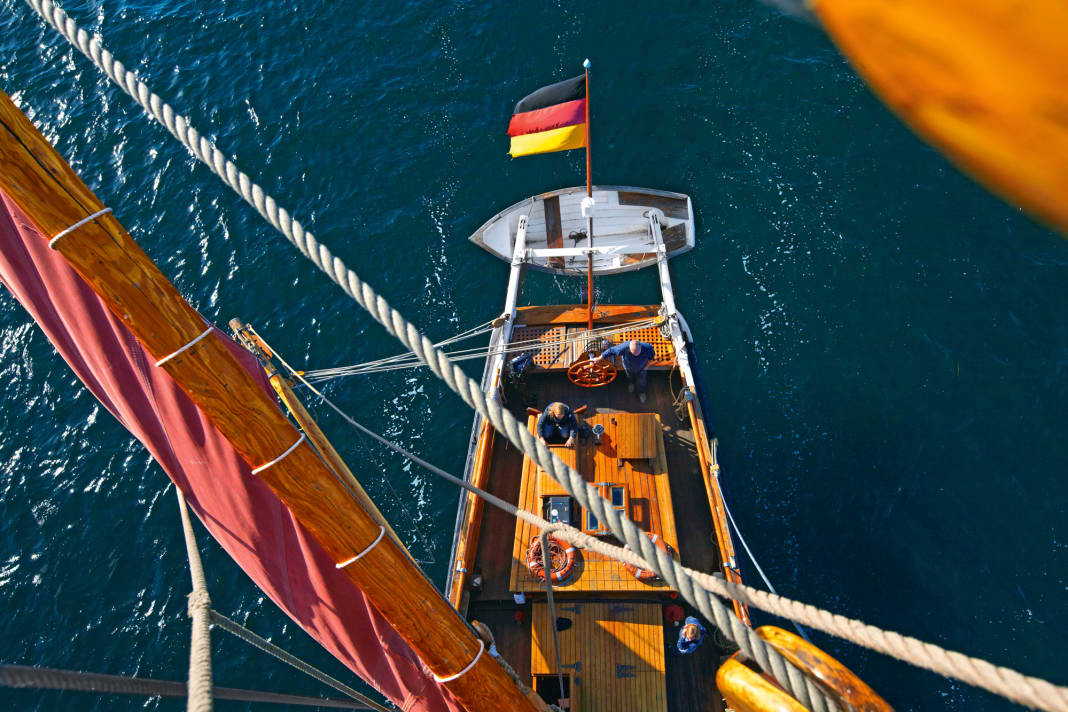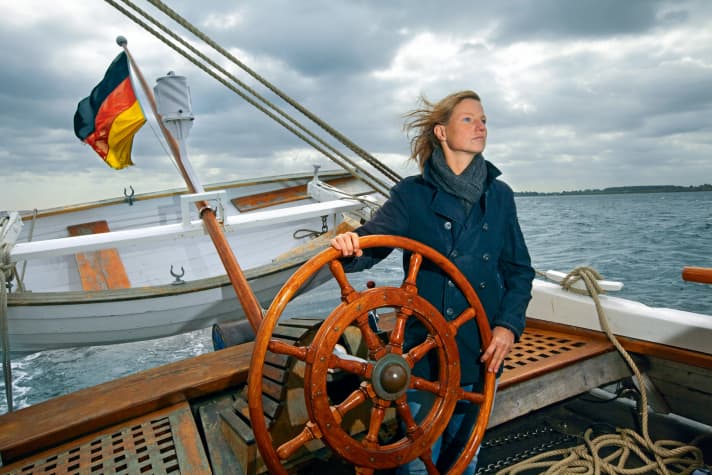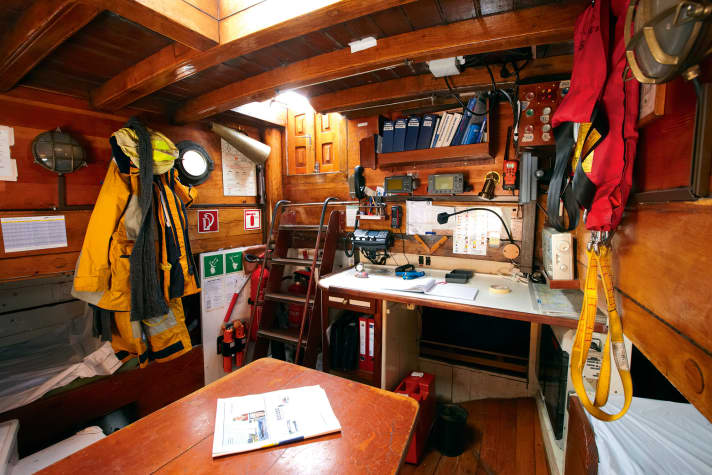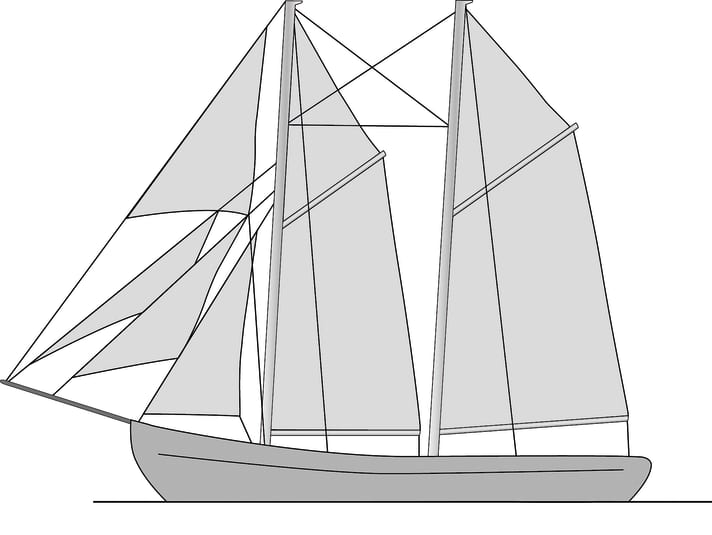Traditional ship to be scrapped: Marstal schooner "Zuversicht" - the colossus of Kiel
Matthias Beilken
· 21.09.2023






Since 2000, the Kiel Youth Sailing Association had operated the 30-metre Marstal schooner "Zuversicht" and organised trips with school classes and youth groups. But because the ship has been lying in the shipyard for two years and there are no funds available for the urgently needed, extensive refurbishment, the "Zuversicht" now has to be scrapped.
YACHT was on board in 2014, when the "Zuversicht" was still sailing in all her glory. The report from back then gives an impression of the ship's history and aura:
There is no doubt that she is the most beautiful ship in the harbour - in the museum harbour. And at 30 metres long, she is also the largest. Two masts on deck, as strong as tree trunks. Above them are spars that look almost delicate, like green wood. The remaining spars - schooner boom and gaffs - look gnarled and graceful at the same time, the branches of the old tree. Its name: "Confidence".
The wooden hull of the ship, built in 1905, is finely black-painted, set off with white rubbing strakes. A white clinker dinghy hangs between the davits. At least from a distance, they give the impression that their canvas pulp is made of cream-coloured Manila hemp.
The gunwale has a glossy natural finish. Below this, the black flanks bulge outwards slightly. Beneath the spoon bow, the foredeck lines are equally wide. Modern yachtsmen would probably call such a belly shape a "tumblehome". But it's not about modernity here in Kiel's museum harbour.
Hundreds of Marstal schooners with the heart-shaped stern were once built
Finally, the typical white-edged heart-shaped transom identifies the "Zuversicht" for what it is: a wooden Marstal schooner, one that is well over 100 years old between the keelson and oak frames. It is probably one of the oldest exhibits of the legendary cargo sailing ships still in service. Danes from the small town of Marstal on Ærø sailed the seas a good 150 years ago on their famous schooners, of which hundreds were built.
The youth sailing club in Kiel tries to maintain the "Zuversicht". At the end of autumn, the scuffed deck bears witness to the work to be done as winter approaches. This is already casting its shadow, even though the ship is still sailing. At least skipper Meike Holland disappears into the engine room for a long time when she comes on board. There she pushes her way past all kinds of units, checks the oil and water levels and checks the drive belts. Only then does the diesel roar to life.
Holland, of delicate stature, was a dinghy regatta sailor from Biggesee - and has always remained one at heart. She has retained her penchant for sharp and skilful manoeuvring. Even though she now lives near Kiel as a mother of two children, she combines the dinghy pragmatism she learnt in Sauerland with solid seamanship and charismatic captaincy. She has sailed on the brig "Roald Amundsen" and other traditional sailing ships. She sails a skerry cruiser privately with her husband, a doctor who manages the on-board pharmacy of the "Zuversicht". Sonja Endres assists the skipper as boatwoman and deckhand.

The "Zuversicht" is the boat for Carsten Jensen's novel "Wir Ertrunkenen"
The stylish folding bridge over the Hörn is about to open. The crew haul in the mooring lines, adult ropes, which they curl up into neat collars. The fenders on board the "Zuversicht" are also somewhat larger, they live under the forecastle. Crawling is the order of the day there. Past the anchor winch, along the chain and to the hawse, which is located in the far corner.
Speaking of corners. The novelist Carsten Jensen sails in almost every corner of this old Marstal cargo schooner. His work "We Drowned" keeps the history of the famous seafaring town omnipresently alive, the "Zuversicht" is the boat to the book, so to speak. Jensen's protagonist, Captain Albert Madsen, is felt to be tugging at the lines.
These old planks will have seen some unpleasant as well as beautiful things.
Seafaring may have been just as necessary in Madsen's day as it is today. One thing it certainly wasn't: funny. Jensen tells of shrunken heads, submarine attacks, lawless scoundrels and sometimes more, sometimes less happy returnees to Marstal. In his opinion, some unpleasant things will have happened on these old planks as well as some beautiful ones. Sailors' happiness, but also hunger, inhuman labour, misery and death.
The "Zuversicht" is a comparatively small working ship. But there are only a handful of people on board. And so everyone has to work really hard to hoist the one-piece Marstal schooner mainsail with its heavy gaff.
Ropes and shackles are rougher, the paths are longer
Under sail, it is downright astonishing how sensitively the giant trough reacts to the leverage of the mainsail on the aft mast and the four headsails - as if the ship were swinging between them. Dropping without furling the main is not an option. Neither is tacking without holding the headsails back. The centre schooner sail has no leverage and is positioned almost exactly above the pivot point.

A second book is also travelling along in spirit: John Leather's marvellous "Gaff Rig Handbook", which explains in words and pictures pretty much everything there is to say about non-triangular sails and the types of boats that carry them. Transfer thinking sets in. The yachtsman's idea that such a piece of fabric on the top is actually just a kind of gennaker or a very high lugsail and that the whole thing should work like that is appealing. However, the ropes and shackles involved are all a bit rougher and the distances are a bit longer.
For example, the main staysail, which rises diagonally upwards from the spreader of the schooner mast to the top of the staysail on the main mast, hinders the running of the topsail halyard. Clearing is only possible directly from the donkey's head on the schooner mast. In other words, it feels like you are 18 metres above deck.
The hull of the "Zuversicht" has a pontoon look to it
The halyard is clear, time for a panoramic view. From above, the secret of the Marstal schooner's cargo efficiency, which is reciprocal to "Zuversicht's" walking speed, is revealed: Sailing in a jagged manner is different. The straight hull sides surround a six metre wide hull, which only merges into the bow and stern at the ends. The whole thing has a pontoon or trough-like appearance; the egg shape familiar from yachts is missing.
But take a closer look: The flanks taper slightly towards the stern. Combined with the deck's sweep and overhanging sides, the result is an image of a ship that is nevertheless elegant, whose lines are bursting with power and suggest a great deal of seaworthiness.
Marstal had the second largest merchant fleet in Denmark after Copenhagen
This must be the case, as Marstal schooners used to be found almost everywhere for a reason: the town had the second largest merchant fleet in Denmark after Copenhagen. Above all, the Danes favoured the foggy fishing grounds on the other side of the Atlantic for cod by the dozen.
Marstal schooners could therefore justifiably be described as the European version of Newfoundland schooners. In general: Bristol trawlers, Thames barges, bisquines, Finkenwerder cutters - marvellous examples of local seafaring. Famous ship types with powerful names from a time when the world was smaller and regionality was still possible. Just like the Marstal phenomenon.
She can't fly. But it will always arrive.
The "Zuversicht" only trembles slightly when it crashes into a wave. It does not brake. But neither does she accelerate jerkily in gusts. The ship is a sailing fact, a constant. It cannot fly. But it will always arrive.
Because the cargo capacity of the Marstal schooners was legendary, the converted "Zuversicht" is the perfect cellar ship today. No saloon, there is only "above" or "below". There is a companionway hatch in the former hatch cover above an almost vertical iron ladder that leads into the former cargo hold. Anyone staying there will not notice much of the activity on deck. Unless they peek through the slit-like windows, which only provide a view of the wooden railing.
The interior of the "Zuversicht" is barely subdivided
"Zuversicht's" interior is barely compartmentalised. There is a galley and the mess room with bunks along the walls, framed by rough, whitewashed ends of oak frames. Separate compartments: No such thing. There are only smaller sleeping quarters at the front. And as skipper, Meike Holland enjoys the privilege of living aft in the chart house in the captain's cabin.

Schleimünde, Maasholm, the heavy mooring lines fly ashore again. The deck planks gleam, just as pitchpine can in the evening sun. No creature comforts here, we eat on the hatch covers. Everyone digs in like a barnstormer. Nobody wants to go ashore, the crew is far too tired. And what's more, their backs are aching. An evening breeze blows across the deck, storm candles flicker in preserving jars. Former club chairman Matthias Heuer and his wife Anke come to visit and talk about the early days.
The "confidence" has also gone deep before
The nucleus that founded the association in 1996 included Schlimbach prizewinner Christoph Bauch. Three years earlier, he had circumnavigated the whole of Scandinavia (St Petersburg-Arkhangelsk-North Cape-Spitsbergen-NOK) for the first time in a mammoth operation with a Wibo steel articulated barge. Meike Holland was there at the time.
Bauch then wanted to go traditional sailing with the church youth of the North Elbian parish. This resulted in today's association. Initially, the equally historic Marstal galleasse "Carola" was brought to Kiel. Later, during a holiday in Denmark, Holland heard about the black schooner "Zuversicht", which was moored in Sonderburg. Bauch and Co. quickly bought it and transferred it to a German shipyard in the autumn of 2000 - where it first went to sea the following day. The deck on which the Labskus dishes now stand had already been covered by harbour water. Nevertheless, the ship managed to get underway again.
The next morning, Holland uses the bow spring to steer the 110-year-old wooden barge away from the pier. Fortunately, it protrudes slightly over the jetty, allowing the bowsprit and water stay to swivel freely while the stern folds down. If the skipper were to turn the bow away from the shore first, the davits, flagpole and dinghy would probably sweep the jetty clean along with the electricity boxes.
Before everyone on deck can make themselves a few sandwiches, six heavy sails are hoisted up the mast under Sonja Endre's direction. As there are no winches on board, the crew can only put as much weight on the ropes as a few hands can pull.
200 people for tasks for which we only have 20."
A passage from Carsten Jensen's book involuntarily comes to mind. He has his protagonist Albert Madsen on his Marstal schooner remark somewhat grumpily at the sight of a ship of the line and its legions of sailors: "Typical navy. 200 people for tasks for which we only have 20."
On board, you feel like the king of the highway
At some point there is silence. The sails stand and pull, the diesel is silent. On the weekend race course between Schlei and Kiel, where dozens of cruising yachts are travelling, you feel like the king of the highway on board the "Zuversicht".
The fjord is reached far too quickly and the engine has to be used again. Time for clearing. The boatwoman does a lonely job packing the sails in the jib net at the front. She tightens the cloth with the foresail downhaul, which looks like crocheting. By the time everything else is packed, the ship is back at the Hörnbrücke.
The lady's breeze prevailing at the berth cannot impress the unsailed schooner - something that weighs about as much as two wagonloads of wood does not immediately drift away in a breeze. And the lady at the helm is certainly not impressed by the gentle breeze.
A few strokes of the engine, then the schooner drifts backwards to its original position, the fore spring follows a heaving line onto the pier, Holland manoeuvres into the gap with centimetre precision. The mizzen rig from her aft neighbour is only a cigarrette box length away from "Zuversicht's" flagpole.
One more mini-push with the 240 hp diesel, then the step on the gunwale is exactly level with the chain passage in the pier railing. End of the day.
Technical data "Confidence"

- Ship type: Marstal schooner
- Year of construction:1905
- Length over everything:30 m
- Torso length: 24 m
- Width: 6 m
- Depth: 2,20 m
- Weight: 60 t
- Sail area on the wind: 320 m²
- Motor:MAN diesel, 240 hp
- Berths/day trip places: 16/30
Verein Jugendsegeln e. V.
Founded 20 years ago, the organisation currently has around 80 members of all ages. The aim is to preserve and operate historic ships and to pass on the necessary knowledge to young people. The members - including active skippers, boatmen and boatwomen - regularly go to sea as boatmen. The association organises regular training and safety courses for them. A boat captain manages and coordinates the necessary overhaul work together with the shipyard team, in which every club member is invited to get involved. The "Zuversicht" is also available to non-members for day trips and longer cruises.

